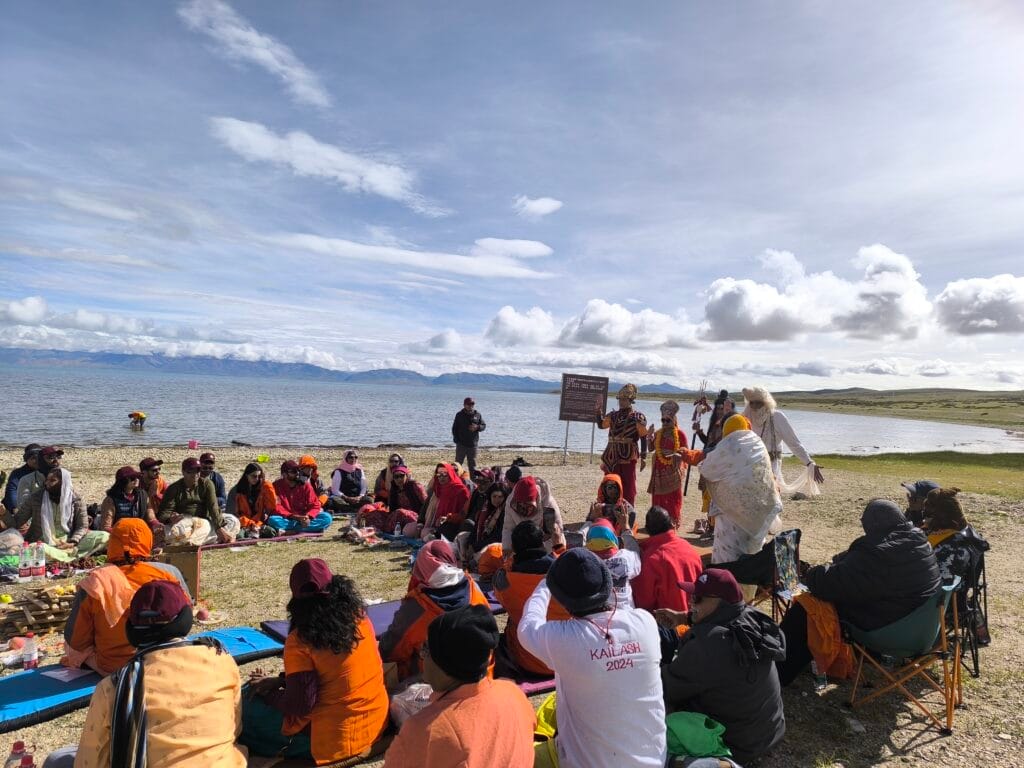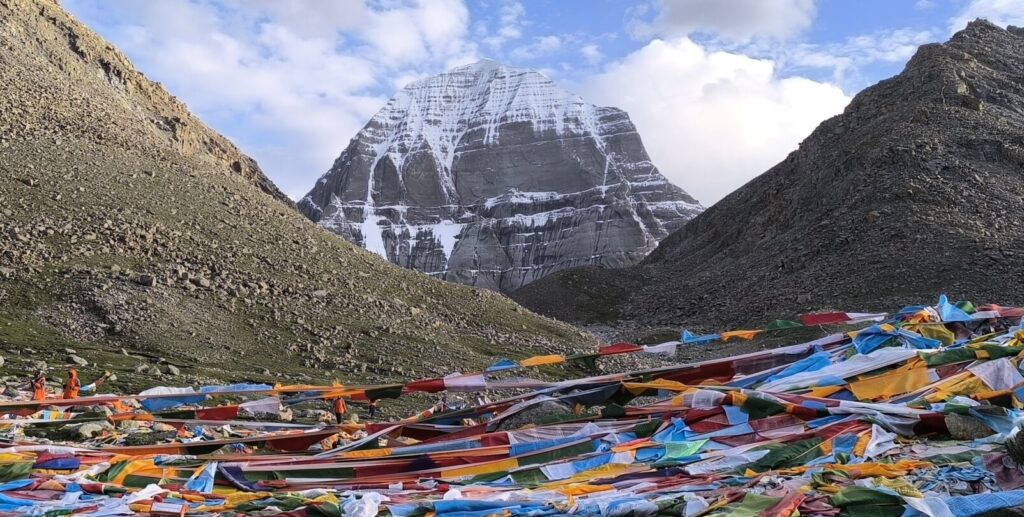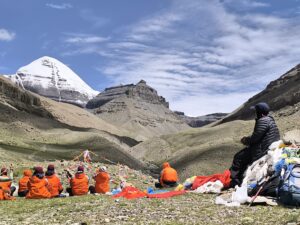Mount Kailash, rising majestically to 6,638 meters in the remote reaches of western Tibet, is not just a mountain—it’s a spiritual epicenter, a symbol of faith, and a place of pilgrimage for millions. Revered across four major religious traditions—Hinduism, Buddhism, Jainism, and Bon, it is often referred to as the “Axis Mundi” or the center of the universe, where heaven meets earth. The journey to Kailash, often called the Kailash Yatra, is a dream for spiritual seekers from all walks of life.
1. Kailash in Hinduism: The Abode of Lord Shiva

In Hinduism, Mount Kailash is believed to be the abode of Lord Shiva, the destroyer and transformer among the Trimurti (Brahma, Vishnu, Shiva). It is where Lord Shiva sits in eternal meditation with Goddess Parvati by his side. Devotees believe that circumambulating (doing parikrama or kora) of the sacred mountain washes away sins of a lifetime and brings ultimate salvation (moksha).
The mountain is also associated with the Ganges River, which is believed to flow from Shiva’s matted hair. Nearby Lake Manasarovar, considered the source of purity, is another holy site where pilgrims take a dip, symbolizing spiritual cleansing.
2. Kailash in Buddhism: A Path to Enlightenment

For Buddhists, Mount Kailash is known as Kang Rinpoche, meaning “Precious Jewel of Snow.” It is believed to be the home of Demchok (Chakrasamvara), a wrathful manifestation of Buddha representing supreme bliss.
Tibetan Buddhists believe that circumambulating Mount Kailash purifies negative karma and brings merit for enlightenment. The clockwise kora (circumambulation) takes about 3 days and covers around 52 kilometers. Buddhists also revere Lake Manasarovar and nearby Rakshastal, seeing the former as a source of positive energy and enlightenment.
Many Buddhists believe that the great sage Milarepa once meditated here, defeating the Bon saint Naro Bon-chung in a spiritual battle, further solidifying its Buddhist significance.
3. Kailash in Jainism: The Site of Liberation
In Jainism, Mount Kailash is known as Ashtapada, where Rishabhanatha (Adinath), the first of the twenty-four Tirthankaras, attained moksha (liberation). It is considered one of the holiest mountains, a place where the soul becomes free from the cycle of birth and rebirth.
Jains perform pilgrimage to honor the enlightenment of Rishabhanatha, although the exact location of Ashtapada is debated among scholars. Still, for devout Jains, Mount Kailash is a sacred symbol of ultimate liberation and spiritual triumph.
4. Kailash in Bon: The Soul of the Ancient Religion
The Bon religion, which predates Buddhism in Tibet, considers Mount Kailash to be the sacred nine-story Swastika Mountain, at the center of the world. Bonpos believe it is the seat of the spiritual power of the sky goddess Sipaimen and home to the great deity Shenrab Miwoche, the founder of Bon.
Unlike Buddhists and Hindus, Bon followers perform the kora counterclockwise, maintaining their distinct ritual practice. For Bon practitioners, Kailash is not just a site for pilgrimage—it is a living presence, a sacred space where the divine world intersects with the human.
The Shared Significance of Kailash
Despite their different beliefs and rituals, what’s profound is how these four religions converge on the spiritual importance of this singular mountain. Mount Kailash, untouched and unconquered by climbers, remains a place of deep spiritual reverence and personal transformation. Each year, pilgrims from around the world make the arduous journey—facing physical challenges but driven by inner devotion—to experience the divine energy of this sacred land.
Whether one walks clockwise or counterclockwise, chants the name of Shiva, meditates on Demchok, reflects on liberation, or honors the Bon deities—Kailash unites all in a shared quest for higher truth, purity, and peace.
Kailash Manasarovar Yatra Packages for 2025/2026

Lhasa to North Everest Base Camp and Kailash Yatra: A Spiritual and Scenic Odyssey Through the Himalayas
Kailash Manasarovar FAQs
🕉️ Spiritual & Cultural FAQs
- What is the Kailash Manasarovar Yatra?
It’s a sacred pilgrimage to Mount Kailash and Lake Manasarovar in Tibet, revered by Hindus, Buddhists, Jains, and Bon followers. - Why is Mount Kailash considered sacred?
Hindus believe it to be the abode of Lord Shiva. Buddhists regard it as the home of Demchok, and Jains associate it with the place of liberation of their first Tirthankara, Rishabhdev. - What is the significance of Lake Manasarovar?
It’s believed to be the source of purity. Pilgrims bathe in or drink its water for spiritual cleansing and merit. - Who can go on the Yatra?
Any adult in good health with a valid passport can go. However, due to high altitudes, physical fitness and medical clearance are essential.
🚶♂️ Travel & Route FAQs
- What are the main routes to reach Kailash Manasarovar?
- Via Nepal (most popular): Kathmandu → Tibet (by road or helicopter)
- Via China: Less common due to restrictions
- How long is the Yatra?
- Via Nepal: 10–15 days depending on the itinerary
- Via India: Around 24 days (Lipulekh route)
- What is the Kailash Parikrama (Kora)?
A 52 km circumambulation of Mt. Kailash, typically done over 3 days. It’s considered the spiritual high point of the Yatra. - What is the best time to go on the Yatra?
May to September is ideal, with July and August being the peak season. Avoid the monsoon and winter months.
🏔️ Health & Fitness FAQs
- Is the Yatra physically challenging?
Yes. The trek reaches altitudes over 5,600 meters (Dolma La Pass), requiring good fitness and acclimatization. - What health precautions should I take?
- Get a full medical check-up
- Train for stamina and strength
- Carry medicines for AMS, cold, and altitude-related issues
- What is the risk of Acute Mountain Sickness (AMS)?
It can be an issue for older age. Gradual acclimatization and hydration help minimize risk. - Can seniors or children go?
Children under 10 are generally not recommended. Seniors (upto 75 years old) must be in excellent health and cleared by a physician.
🧳 Logistics & Packing FAQs
- What permits and documents are required?
- Valid passport (6+ months validity)
- Tibet Travel Permit (processed through authorized agents or Indian government)
- Chinese visa
- What should I pack for the Yatra?
Warm layered clothing, trekking shoes, thermal wear, rain gear, sun protection, personal medications, and snacks. - Is the food vegetarian?
Yes, most organized yatras provide vegetarian meals suited for Indian pilgrims. - What kind of accommodation is available?
Basic lodges, tents, and guesthouses. Facilities are very modest, especially in remote areas.
📶 Practical Travel FAQs
- Is there mobile or internet connectivity?
Limited. In Tibet, Chinese SIM cards may work, but don’t expect consistent coverage. - Is travel insurance necessary?
Absolutely. It should cover high-altitude trekking, evacuation, and trip cancellations. - Do I need to join an organized group?
Yes. Independent travel to Kailash is not permitted. You must go with a registered tour operator in Nepal or through the Indian government program.
Why choose us?
At DreamKailash.com i.e RP Adventures Pvt. Ltd., we are more than just a travel company — we are a dedicated team of spiritual journey facilitators who specialize in the Kailash Manasarovar Yatra. Our mission is to provide a deeply meaningful, safe, and life-changing pilgrimage experience to one of the most sacred destinations on earth.
✅ Deep Cultural & Spiritual Insight
Our team holds in-depth knowledge of the cultural, historical, and spiritual significance of Mt. Kailash and Lake Manasarovar. We don’t just take you there — we guide you through the essence and traditions of this sacred land, helping you connect with the experience on a soul level.
✅ Specialized Focus
Unlike general travel companies, we exclusively focus on Kailash Manasarovar Yatra. This specialization allows us to fine-tune every detail of your journey — from route planning and permits to high-altitude preparedness and cultural briefings.
✅ Trusted by Pilgrims Worldwide
We have earned the trust of hundreds of pilgrims from around the world who return with not only memories but with transformed hearts and renewed spirits.
✅ Passionate & Experienced Team
With years of hands-on experience leading the Kailash Yatra, our passionate guides and support staff understand the terrain, the logistics, and the emotional depth of the journey. Your safety, comfort, and spiritual fulfillment are always our top priorities.
✅ Personalized Care & Seamless Service
Whether you’re traveling solo or with a group, we treat every pilgrim as part of our family. Our personalized approach ensures that your physical needs and spiritual aspirations are met with care and compassion.
